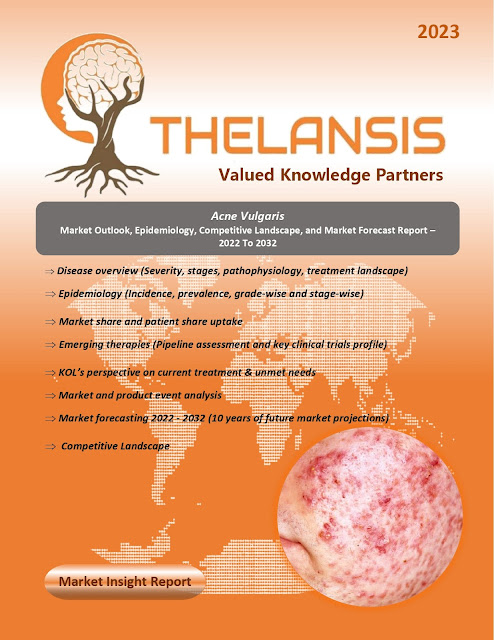Premenstrual Dysphoric Disorder (PMDD) – Market Outlook, Epidemiology, Competitive Landscape, and Market Forecast Report – 2023 To 2033
Premenstrual Dysphoric Disorder (PMDD) is a depressive disorder categorized as "not otherwise specified" in the Diagnostic and Statistical Manual of Mental Disorders published by the American Psychiatric Association. It is characterized by mood, appetite, energy, and cognitive changes that manifest during the menstrual cycle's late luteal (premenstrual) phase and subside shortly after the onset of menses. The onset of symptoms is closely linked to the late luteal phase, which coincides with declining levels of estrogen and progesterone. Symptom relief typically occurs during the initial days of the follicular phase when estrogen levels increase due to ovarian follicular growth. The exact cause of PMS/PMDD remains unknown. However, certain risk factors are associated with the development of the condition, some of which have been well-established, while others are still speculative. Proven Risk Factors:
- Past traumatic events: Traumatic experiences and preexisting anxiety disorders are identified as risk factors for PMDD.
- Cigarette smoking: A significant link exists between moderate-to-severe forms of PMS and current smoking status, with an elevated risk for former smokers.
- Obesity: A clear linear relationship exists between baseline Body Mass Index (BMI) and the risk of incident PMS. Each 1 kg/m2 increase in BMI is associated with a significant 3% increase in risk.
Speculative Risk Factor:
- Genetics: Heritable factors play a role in developing PMS/PMDD. The involvement of specific genes, such as the one coding for the serotonergic 5HT1A receptor and allelic variants of the estrogen receptor alpha gene (ESR1), in developing PMS/PMDD.
The symptoms of PMDD may overlap with other psychiatric disorders, particularly major depression. Thus, it is crucial to rule out the presence of another existing disorder before confirming the diagnosis of PMS/PMDD. The key factor in diagnosing PMDD is the temporal association of symptoms with the menstrual cycle. Pharmacological approaches to managing PMDD include the use of psychotropic agents and hormonal therapies:
- Psychotropic agents: Selective serotonin reuptake inhibitors (SSRIs) have been shown to treat severe mood and somatic symptoms of PMDD effectively. Antidepressants that primarily affect noradrenergic transmission are less effective for PMDD, indicating that the beneficial effects of SSRIs are not solely due to their antidepressant properties. The positive effects of SSRIs on PMDD symptoms manifest rapidly compared to their antidepressant effects.
- Benzodiazepines (BZDs): BZDs like alprazolam can be effective in women with severe anxiety and premenstrual insomnia. However, caution is advised due to the risk of dependence, especially in cases with a history of substance abuse.
- Suppression of Ovulation: Hormonal therapies can be considered for severe symptoms of PMDD.
Danazol: This synthetic partial androgen agonist/antagonist and gonadotropin inhibitor has demonstrated efficacy in treating PMDD by inhibiting ovulation. However, it is associated with hirsutism and teratogenicity, making it less preferred as an initial treatment. - Oral contraceptive pills (OCPs): While commonly used in clinical practice. Women on OCPs may experience hormone-related symptoms during hormone-free days, suggesting that OCPs with fewer hormones might benefit more. Drospirenone, a gestagen, has effectively treated PMDD symptoms due to its anti-aldosterone and anti-androgenic effects.
- Up to 80% of women in the United States go through emotional, behavioral, or physical premenstrual symptoms. Additionally, approximately 3% to 8% of women meet the diagnostic criteria for PMDD.
Thelansis’s “Premenstrual Dysphoric Disorder (PMDD) Market Outlook, Epidemiology, Competitive Landscape, and Market Forecast Report – 2023 To 2033" covers disease overview, epidemiology, drug utilization, prescription share analysis, competitive landscape, clinical practice, regulatory landscape, patient share, market uptake, market forecast, and key market insights under the potential Premenstrual Dysphoric Disorder (PMDD) treatment modalities options for eight major markets (USA, Germany, France, Italy, Spain, UK, Japan, and China).
KOLs insights of Premenstrual Dysphoric Disorder (PMDD) across 8 MM market from the centre of Excellence/ Public/ Private hospitals participated in the study. Insights around current treatment landscape, epidemiology, clinical characteristics, future treatment paradigm, and Unmet needs.
Premenstrual Dysphoric Disorder (PMDD) Market Forecast Patient Based Forecast Model (MS. Excel Based Automated Dashboard), which Data Inputs with sourcing, Market Event, and Product Event, Country specific Forecast Model, Market uptake and patient share uptake, Attribute Analysis, Analog Analysis, Disease burden, and pricing scenario, Summary, and Insights.
Thelansis Competitive Intelligence (CI) practice has been established based on a deep understanding of the pharma/biotech business environment to provide an optimized support system to all levels of the decision-making process. It enables business leaders in forward-thinking and proactive decision-making. Thelansis supports scientific and commercial teams in seamless CI support by creating an AI/ ML-based technology-driven platform that manages the data flow from primary and secondary sources.




Comments
Post a Comment